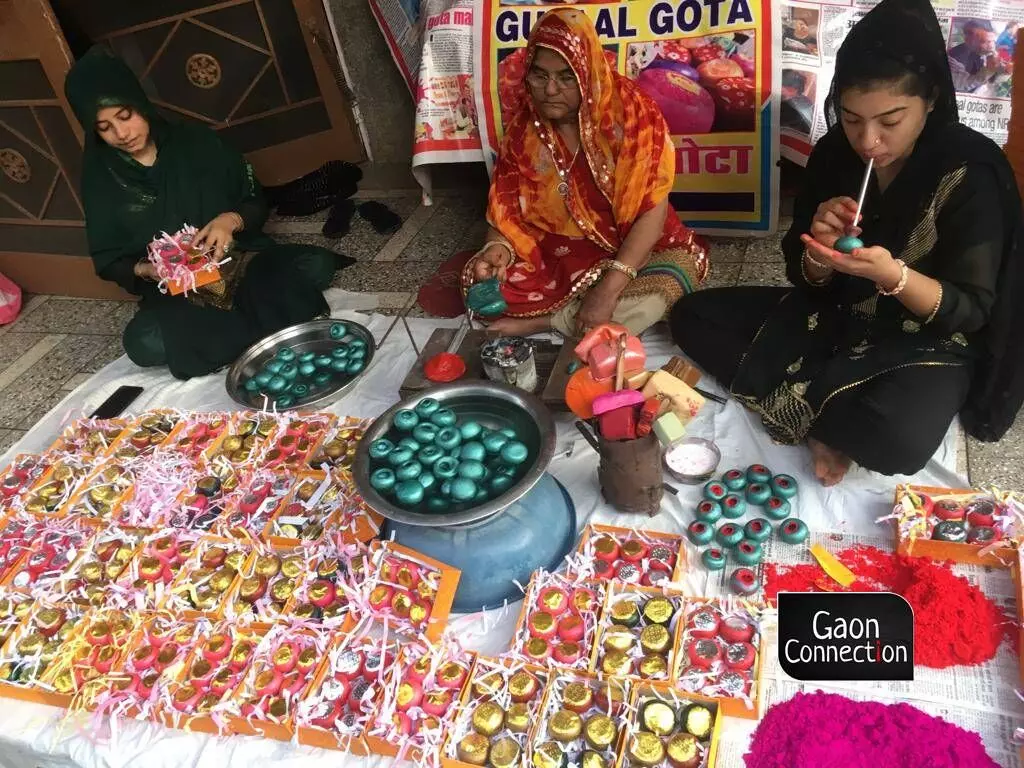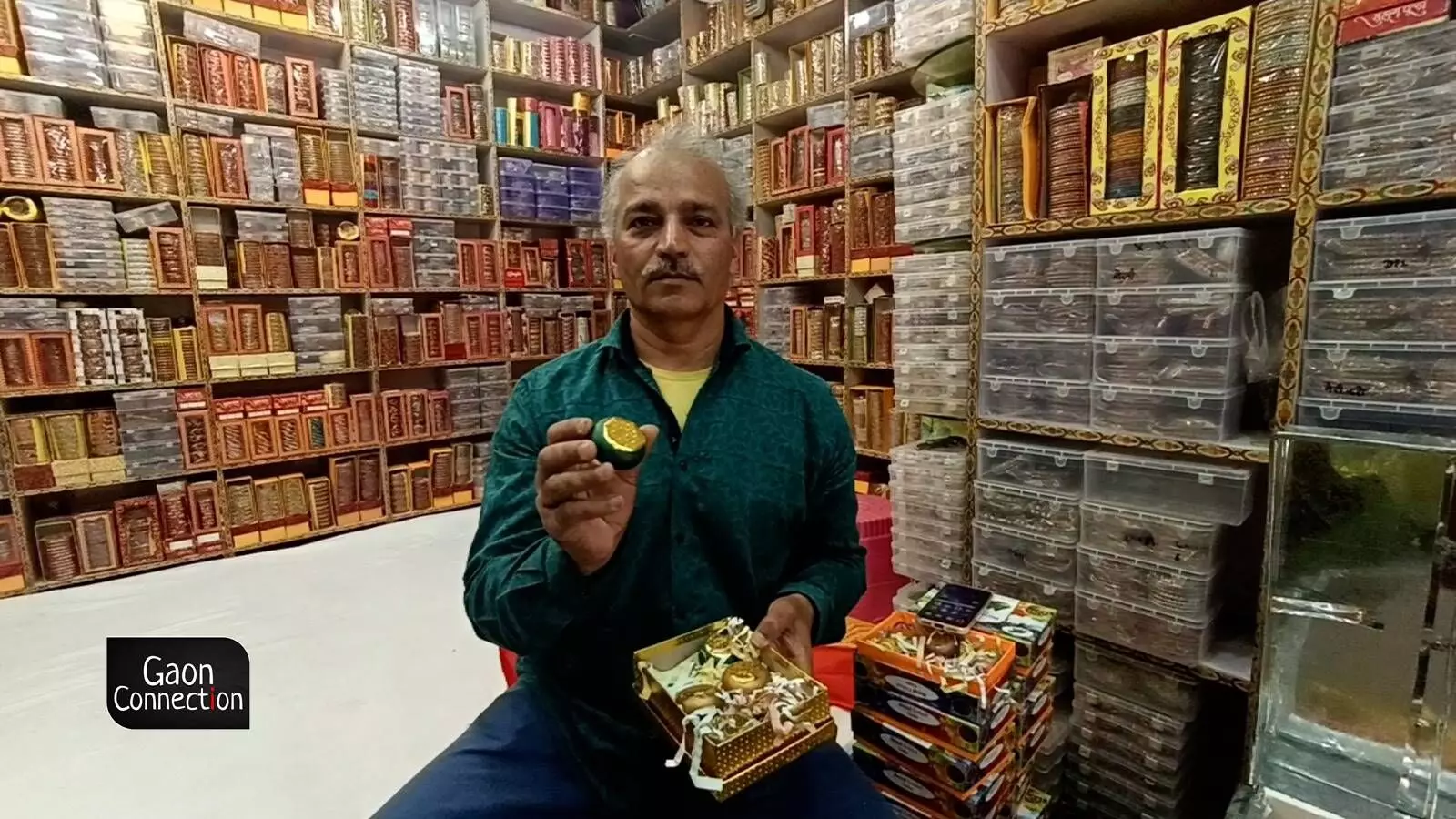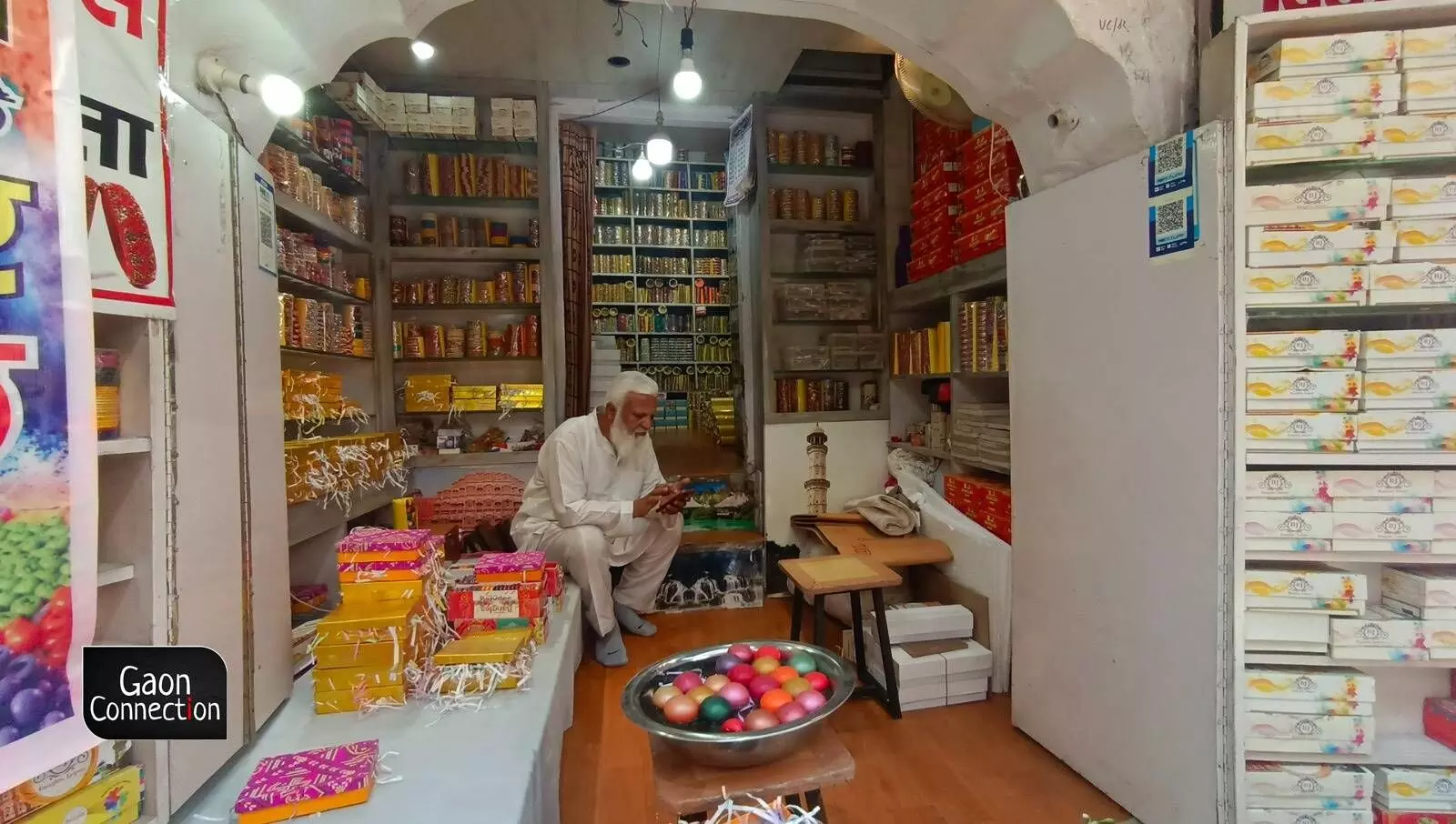Jaipur, Rajasthan
Maniharon-ka-Raasta in Jaipur is congested and a burst of sound and colour. Two wheelers wobble precariously as they make way for cattle that saunter leisurely down the lane.
On either side are shops with an astonishing collection of lac bangles and gulaal gota. These are soft lac spheres filled with dry colours, sealed and then used to chuck at people during Holi. Jaipur’s tradition of playing Holi with gulaal gota is over 400 years old.
And Maniharon-ka-Raasta is the hub of artisans who for the past several generations have been making gulaal gota for Holi.
“You can still see paintings on the walls of Jaipur City Palace of people sitting on elephants, throwing gulaal gotas on each other. These were made for the members of the royal family and courtesans. Our ancestors were commissioned to make them and they would sell them to the court,” Mohammad Sadique, a 55-year-old gulaal gota maker, told Gaon Connection. There are shopkeepers like Sadique in Manihaaron-ka-Raasta who are the 12th or 14th generation of bangle-makers and gulaal gota-makers in the city.
“As the Holi festival arrives, there is a demand for gulaal gota. My grand-father and father have sold them to celebrities and politicians. It is a time-taking process to make the gotas, but we enjoy it,” Amaan, who said he was the 14th generation in his family to make bangles and gulaal gotas. His shop at Maniharon-ka-Raasta in Tirpolia Bazaar, is stacked with colourful cardboard boxes of gulaal gotas ready to be sold.

The pandemic brought a lull to the business of gulaal gota.
Ever since Maharaja Sawai Jai Singh-11 invited the bangle makers to live in Maniharon-ka-Raasta in 1727, it has been a hub of artisans, predominantly Muslims, who have created beautiful lac bangles. Before the ruler of Jaipur invited them to live within the Walled City, they lived in the nearby town of Shahpura.
Also Read: Herbal Holi With Colours Made of Beetroots, Spinach And Marigolds
Gulaal Gota
“Lac is boiled in water first and then the colours are added to it,” Mohammad Noman, a lac craftsman, told Gaon Connection.
“We start working at least two months before Holi to complete the orders. We heat the lac, blow them into balls with the help of the phunkni — a blower. The lac spheres are very thin. A couple of grams of gulaal are spooned into them. Then the gotas are sealed and wrapped in brightly coloured paper to make them look attractive. They are so light that when thrown at somebody, there is no damage done at all,” Noman added.

Five-star resorts also organise special Holi festivals where thousands of gulaal gota are procured for their guests.
The price of the gulaal gotas vary depending on the quality of the gulaal used in it. “Usually, each piece costs around Rs 25, but it can go up to Rs 35,” Noman said.
According to him, if the customers demand the gulaal being used be scented with sandalwood or some other fragrance, the price rises. A box of gulaal gotas (usually six to a box) can cost anything from Rs 100 to Rs 150. The gulaal is usually organic and safe to use, the artisans of Maniharon-ka-Raasta, said.
Also Read: Phag and nagadiya add colour to the Holi festival in Baghelkhand region of Madhya Pradesh
“We get orders from Jaipur, Ajmer, Jodhpur and Jaisalmer in Rajasthan. We also send them to Delhi, Kolkata, Lucknow, Ahmedabad and Bengaluru,” Noman added.
The boxes of gulaal gotas are packed carefully using shredded paper and thermocol, and transported in private buses to different destinations. “We do paste stickers that say these are fragile, but sometimes a few pieces are damaged, but then, that is part of business,” the craftsman said.
Religion no bar
“If you come home now you will see my home filled with colours. My family members work day and night to complete orders. We also make lac bangles that women from all communities wear and are gifted to Hindu brides. It is a bond that goes back centuries,” Mohammad Sadiq, said with pride to Gaon Connection. The 54-year-old craftsman reiterated that there were no religious divides when it came to their profession.
The pandemic brought a lull to the business of gulaal gota. People did not celebrate Holi for almost two years and those who did, rarely ordered the gotas, said Mohammad Shamshera, another artisan.
“The market is opening up slowly but the rate of lac has shot up in the last five months. People did not expect there to be such a demand for gulaal gota this year. The demand is there, but the raw material is not available or it is too expensive,” Shamshera told Gaon Connection.
But, the business is still thriving as Maniharon-Ka Rasta is a tourist hub. Five-star resorts also organise special Holi festivals where thousands of gulaal gota are procured for their guests.

Maniharon-ka-Raasta is the hub of artisans who for the past several generations have been making gulaal gota for Holi.
Also Read: Dried flowers, fire, and merry making mark the Holi of Adivasis in Chhattisgarh
“This is what we do. This is our identity and I am pretty sure this is what our families will do for the next 14 generations at least,” Mohammad Shan, a 20-year-old artisan, told Gaon Connection. “This is not a mere job but our identity and we will never stop doing what we do,” he said.
The crowds increase gradually at the shops as people stock up on the gulaal gotas. Side by side, in many shops piles of the colourful gulaal disappear into the gotas and are sealed, to be thrown on revellers on Holi, and showering them with the vibrant, joyful colours of spring.
Happy Holi!




















